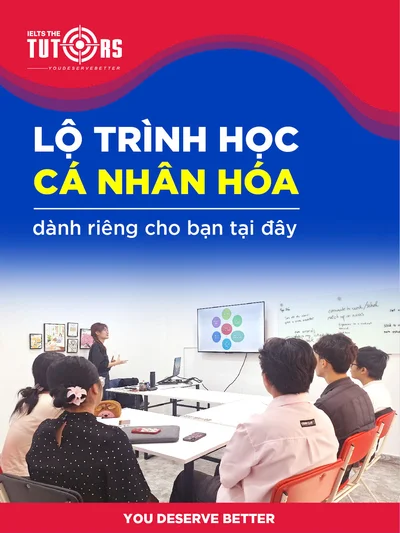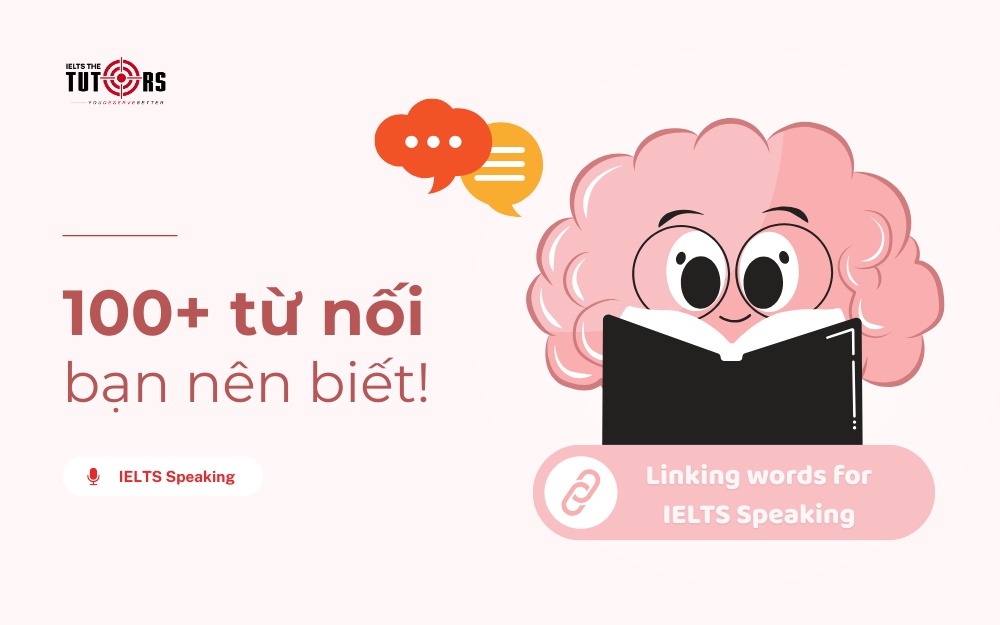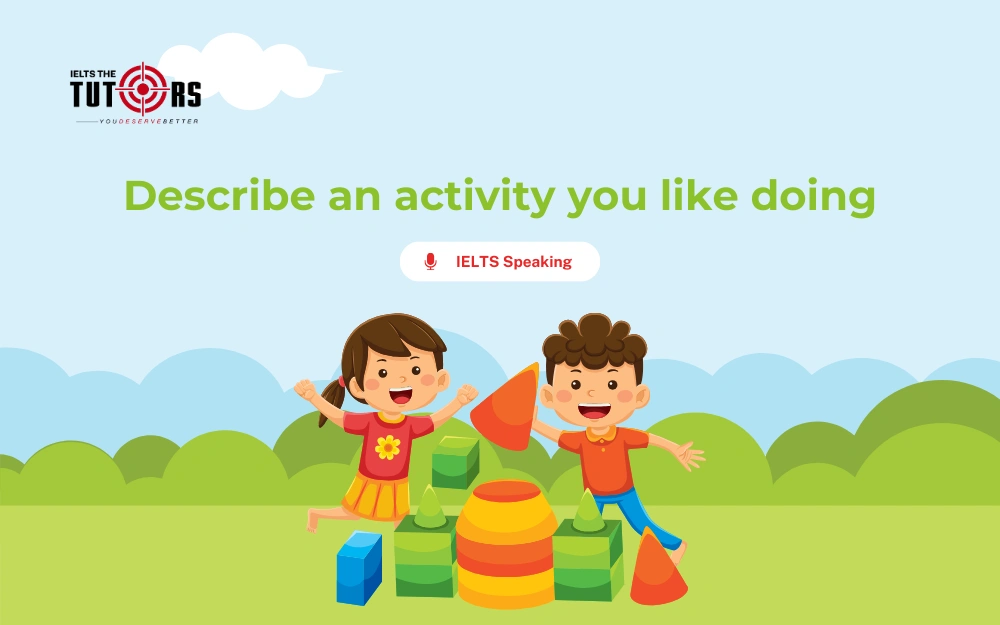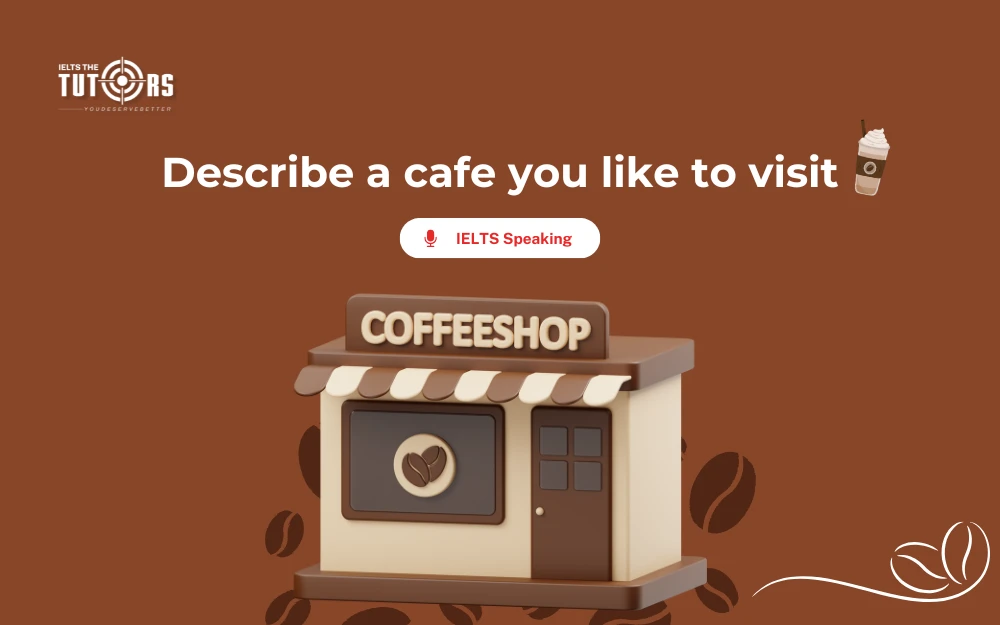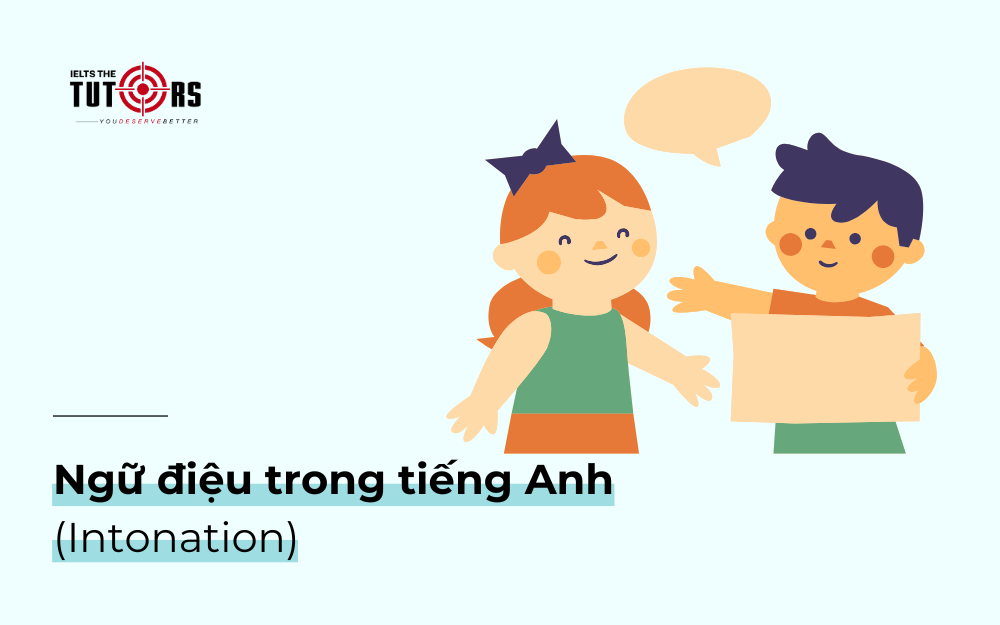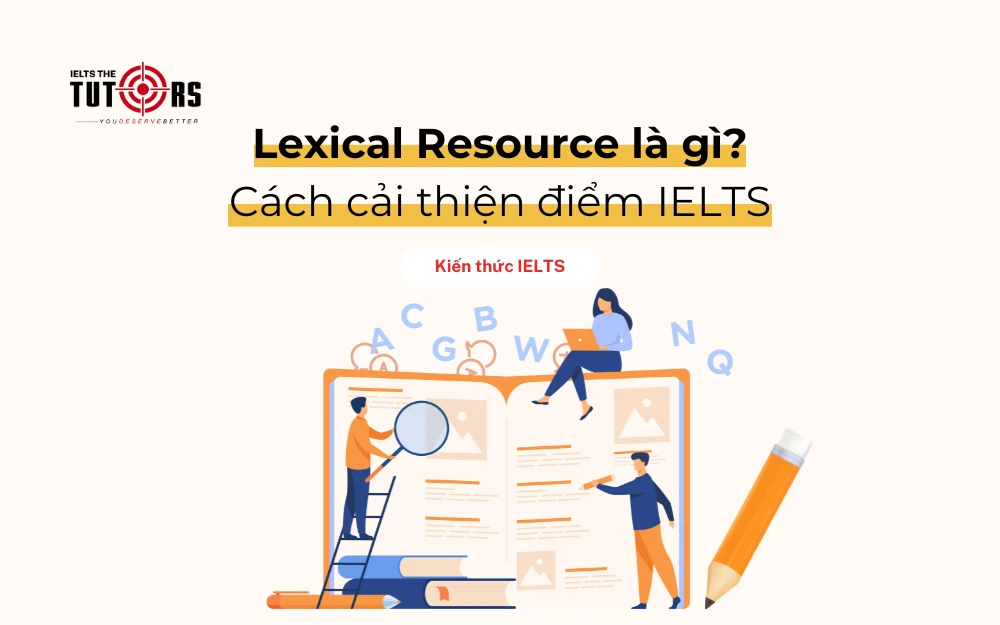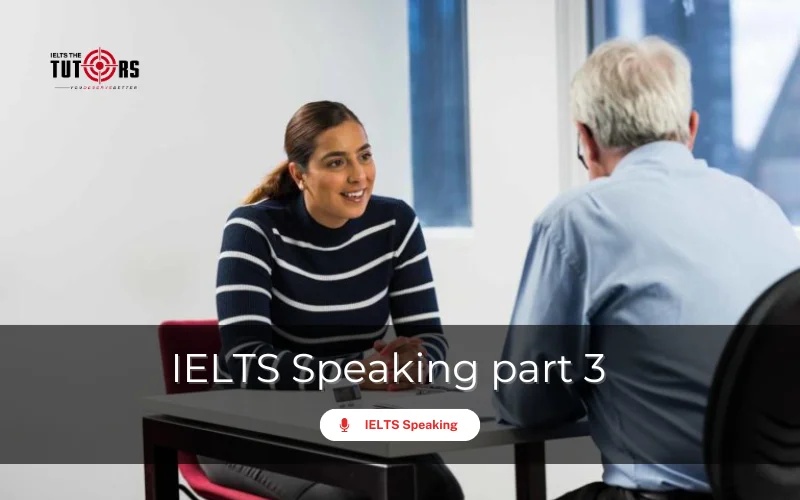
Trong các bài viết trước, IELTS The Tutors đã chia sẻ định hướng, chiến thuật trả lời bài IELTS Speaking part 1 và part 2 giúp bạn biết cách luyện tập và tối ưu band điểm của mình. Hôm nay, chúng ta sẽ cùng tìm hiểu tiếp phần cuối cùng của bài thi này đó là IELTS Speaking part 3 để hoàn thiện kỹ năng nói của mình nhé!
Tổng quan về IELTS Speaking part 3
IELTS Speaking Part 3 là phần thi nói với hình thức thảo luận hai chiều (Two-way Discussion) sâu hơn về chủ đề ở Part 2. Phần thi này đánh giá khả năng diễn đạt ý kiến, lập luận, phân tích và sử dụng ngôn ngữ phức tạp. Giám khảo sẽ đặt ra các câu hỏi mang tính trừu tượng để bạn đào sâu vào các khía cạnh của chủ đề.
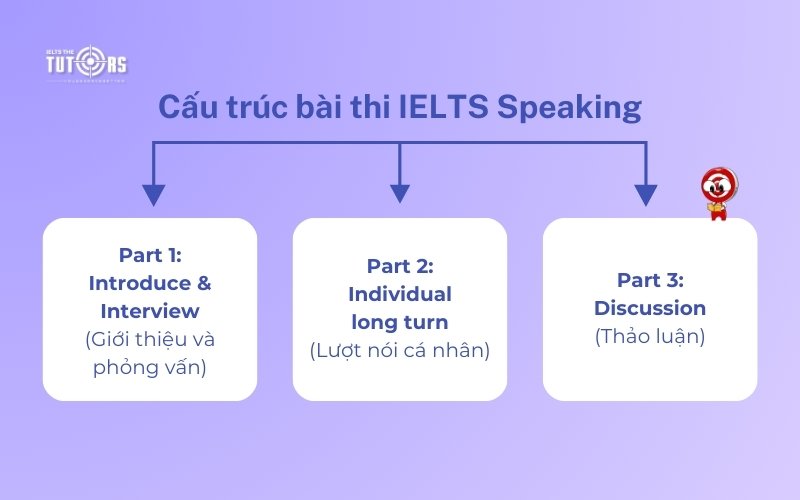
IELTS Speaking part 3 diễn ra trong khoảng 4 – 5 phút với các dạng câu hỏi sau:
- Opinion question (câu hỏi nêu quan điểm)
- Comparison questions (câu hỏi so sánh)
- Cause and Effect questions (câu hỏi về nguyên nhân và hậu quả)
- Advantage and Disadvantage questions (câu hỏi về lợi ích và bất lợi)
- Problem and Solution questions (câu hỏi về vấn đề và giải pháp)
- Evaluation questions (câu hỏi đánh giá)
- Speculative questions (Câu hỏi dự đoán)
Dưới đây là một vài chủ đề thảo luận để bạn có cái nhìn rõ hơn về phần thi này:
| Part 2 long turn | Possible part 3 topic areas | Câu hỏi Part 3 |
| Describe a book you enjoyed reading. | Reading habits, education, technology, literature, media | Why do some people prefer reading books to watching movies? |
| Describe a time when you helped someone. | Community, volunteering, social values, personal development | How can helping others benefit both the helper and the person being helped? |
| Describe a place you have visited. | Tourism, cultural exchange, environment, globalization | What are the impacts of tourism on local communities? |
Các chủ đề thường gặp trong IELTS Speaking part 3
Các câu hỏi trong IELTS Speaking part 3 thường mở rộng từ chủ đề của cue card trong Part 2. Ví dụ, nếu Part 2 nói về một chuyến đi, Part 3 có thể hỏi về lợi ích của du lịch hoặc tác động của du lịch đến môi trường. Dưới đây là các chủ đề phổ biến:
- Hometown
- Hobbies
- Study
- Food
- Education
- Accommodation
- Travel & Leisure
- Sports & Exercise
- Technology & Media
- Social Relationships
- Books
- Health
- Environment
- Music
- Shopping
- Transportation
- Job
- Art
- Language
- Advertisement
- Globalization
- Cultural Diversity
- Mental Health
- Urbanization
- Sustainability
Xem thêm: IELTS Speaking topics, danh sách chủ đề IELTS mới nhất
Cách trả lời IELTS Speaking part 3
IELTS Speaking Part 3 là nơi bạn thể hiện khả năng tư duy sâu sắc và giao tiếp linh hoạt về các vấn đề xã hội, văn hóa, hoặc môi trường. Không giống Part 1 (câu hỏi cá nhân) hay Part 2 (bài nói cá nhân), Part 3 yêu cầu bạn thảo luận khái quát và trừu tượng, tránh tập trung vào bản thân hay gia đình. Giám khảo sẽ hướng bạn đến các chủ đề rộng hơn, như xu hướng xã hội, thói quen văn hóa, hoặc giải pháp cho các vấn đề chung.
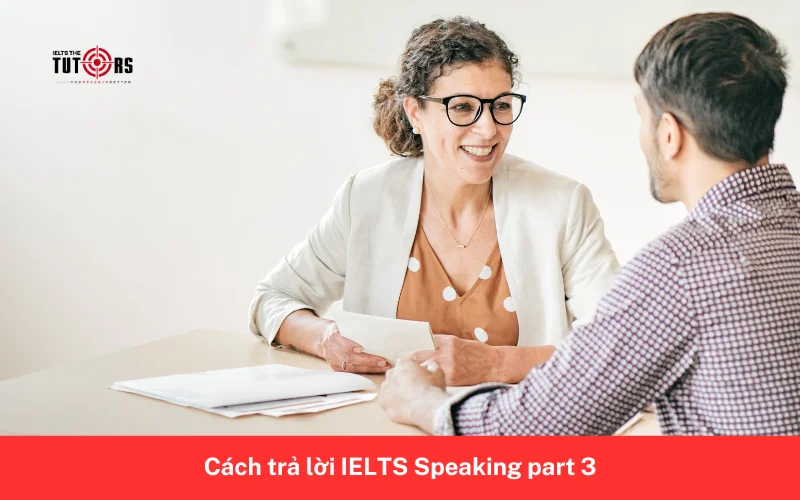
Đây là cơ hội để bạn chứng minh năng lực ngôn ngữ ở mức cao, từ việc sử dụng từ vựng học thuật, cấu trúc ngữ pháp phức tạp, đến cách lập luận logic. Để làm tốt, bạn cần biết cách chuyển từ góc nhìn cá nhân sang thảo luận bao quát, đồng thời thể hiện quan điểm rõ ràng và thuyết phục.
Thay vì nói “I think…” hoặc kể chuyện cá nhân, hãy sử dụng các cụm từ khái quát để đưa ý kiến của thí sinh vào bối cảnh rộng hơn:
- “In my country, it’s common for people to…”
→ Ví dụ: “In my country, it’s common for people to prioritize academic success over hobbies, as education is seen as a pathway to a stable career.”
- “Compared to other countries, my country…”
→ Ví dụ: “Compared to Western countries, Vietnam places greater emphasis on family gatherings during holidays like Tet.”
- “From a broader perspective…”
→ Ví dụ: “From a broader perspective, technology has revolutionized how people communicate globally.”
- “One major issue in my city is…”
→ Ví dụ: “One major issue in my city is traffic congestion, which could be addressed by improving public transportation.”
- “A common trend nowadays is…”
→ Ví dụ: “A common trend nowadays is the rise of remote working, which offers flexibility but also challenges work-life balance.”
- “To tackle this issue, society could…”
→ Ví dụ: “To tackle environmental pollution, society could promote recycling programs and stricter regulations on industries.”
Tham khảo: IELTS Speaking Vocabulary: Tổng hợp từ vựng theo 16 chủ đề
Sử dụng từ nối
Trong IELTS Speaking Part 3, từ và cụm từ nối (discourse markers) là công cụ mạnh mẽ giúp bạn trình bày ý tưởng mạch lạc, logic và tự nhiên. Chúng không chỉ kết nối các ý trong câu trả lời mà còn thể hiện thái độ, cảm xúc, và khả năng tổ chức ngôn ngữ của bạn. Quan trọng hơn, việc sử dụng từ nối đúng cách giúp bạn đáp ứng tiêu chí Fluency and Coherence và Lexical Resource, đồng thời tạo ấn tượng với giám khảo rằng bạn có thể thảo luận các chủ đề trừu tượng một cách trôi chảy.
Tuy nhiên, bạn cần tránh những lỗi phổ biến, như lạm dụng fillers vô nghĩa (e.g., “um”, “er”, “ah”) hoặc các từ lặp lại như “you know”, “like”. Những từ này có thể khiến giám khảo nghĩ rằng bạn thiếu vốn từ hoặc không tự tin. Thay vào đó, hãy sử dụng các từ nối phù hợp và fillers tự nhiên (e.g., “well”, “let me think”) để tranh thủ thời gian suy nghĩ mà vẫn nghe chuyên nghiệp.
Dưới đây là các từ nối (linking verb) phổ biến, phân loại theo mục đích, kèm ví dụ ngắn và mẹo sử dụng:
- Trình tự, sắp xếp thứ tự ý: to begin with, secondly, thirdly, subsequently, later, after this, finally
- Thêm thông tin: additionally, besides, what’s more, another good example of this is, and one more thing, …
- Thể hiện ý kiến: personally, to be honest, unfortunately, however, actually, essentially, definitely, basically, frankly, clearly, I'm afraid, sadly, in fact, if you ask me, as a matter of fact, …
- So sánh: on the one hand, in contrast, whereas, similarly, likewise, although, despite, instead of, on one hand, in the opposite way, on the other hand, in contrast, whereas, …
- Đưa ví dụ: for example, such as, a clear example is, for instance, a classic example is, illustrated by, a personal example is, in other words, …
- Trì hoãn suy nghĩ: well, let me think, that’s a good question, I haven't thought of that before, basically, actually, …
- Khái quát: generally speaking, on the whole, it is often said that, in most cases, a small minority of, the vast majority of.
- Kết quả: therefore, as a result, consequently, so, then.
Mở rộng phạm vi trả lời
IELTS Speaking Part 3 là cơ hội để bạn chứng minh khả năng thảo luận sâu và linh hoạt về các chủ đề trừu tượng. Thay vì trả lời ngắn gọn, bạn cần mở rộng ý để thể hiện tư duy logic, vốn từ phong phú, và sự tự tin. Giám khảo muốn thấy bạn có thể khai thác chủ đề ở mức độ sâu, vì vậy việc chuẩn bị các chiến lược ngôn ngữ và luyện tập với các chủ đề phổ biến là rất quan trọng.
Bày tỏ ý kiến rõ ràng
- Ví dụ: “Why is education important?”
→ “In my view, education equips people with skills for better careers and fosters critical thinking.”
Đồng ý hoặc phản đối
- Ví dụ: “Do you agree that technology harms social interaction?”
→ “I partly disagree because technology connects people globally, though it can reduce face-to-face interaction.”
Phân tích lợi ích và bất lợi
- Ví dụ: “What are the advantages of living in cities?”
→ “Cities offer job opportunities and modern facilities, but they also face issues like traffic congestion.”
Giải thích lý do
- Ví dụ: “Why do people prefer online shopping?”
→ “People choose online shopping because it’s convenient and offers a wider range of products.”
Đưa ví dụ cụ thể
- Ví dụ: “How does recycling help the environment?”
→ “Recycling reduces waste. For instance, sorting plastic in my city has cut landfill use by 20%.”
Mô tả tình hình tại quốc gia
- Ví dụ: “How do people celebrate holidays in your country?”
→ “In Vietnam, Tet is celebrated with family reunions and traditional foods like banh chung.”
Dự đoán tương lai
- Ví dụ: “How will technology change education?”
→ “In the future, AI might personalize learning, making education more effective.”
Đánh giá tầm quan trọng
- Ví dụ: “How important is learning a foreign language?”
→ “It’s extremely important as it opens career opportunities and promotes cultural understanding.”
Đề xuất giải pháp
- Ví dụ: “How can we reduce pollution?”
→ “Governments could promote public transport and enforce stricter waste regulations.”
So sánh điểm giống và khác
- Ví dụ: “How do city and rural life differ?”
→ “City life is fast-paced with better facilities, whereas rural areas are calmer with stronger community ties.”
Yêu cầu làm rõ (nếu cần)
- Ví dụ: “Could you clarify what you mean by ‘sustainable development’?”
Để có thể mở rộng ý cho câu trả lời IELTS Speaking part 3, bạn cần phải chuẩn bị trước cho các chủ đề phổ biến như Education, Environment, Technology, … cũng như tích lũy một vốn từ vựng đủ lớn.
Sử dụng đa dạng cấu trúc ngữ pháp
Trong IELTS Speaking Part 3, việc sử dụng các cấu trúc ngữ pháp đa dạng giúp bạn chứng minh khả năng diễn đạt ý tưởng linh hoạt và chính xác. Kết hợp đúng ngữ pháp với các chức năng ngôn ngữ (như mô tả, dự đoán, so sánh) không chỉ làm câu trả lời phong phú mà còn ghi điểm ở tiêu chí Grammatical Range and Accuracy. Điều này đặc biệt quan trọng để đạt band 7.0+, khi giám khảo mong đợi bạn sử dụng câu phức, cấu trúc nâng cao, và ít sai sót.
Dưới đây là hướng dẫn cách dùng ngữ pháp phù hợp với các chức năng ngôn ngữ phổ biến:
- Mô tả tình hình tại quốc gia: Thì hiện tại đơn (mô tả thói quen/xu hướng), hiện tại hoàn thành (thay đổi qua thời gian), hoặc quá khứ đơn (sự kiện cụ thể).
- Dự đoán tương lai: Thì tương lai (will, going to), động từ khiếm khuyết (may, might, could), hoặc câu điều kiện (if).
- Đề xuất giải pháp: Động từ khiếm khuyết (should, could), câu điều kiện (if… then…), hoặc cụm “It’s advisable to…”.
- So sánh điểm giống và khác: Cấu trúc so sánh hơn (more… than), so sánh ngang bằng (as… as), hoặc từ nối (whereas, while).
Ví dụ mẫu câu trả lời Part 3
Dưới đây là một số IELTS Speaking part 3 questions and answers mẫu tham khảo dành cho bạn:
Question 1: How has technology changed the way students learn in recent years?
Sample answer: Technology has completely transformed how students learn in recent times, making education far more interactive and accessible than ever before. Take, for example, the use of educational apps and online platforms – these tools allow students to explore topics at their own pace and dive into resources like video tutorials or e-books whenever they need. This flexibility is a game-changer, especially for those who struggle with traditional methods. On top of that, in classrooms, things like interactive whiteboards have made lessons more engaging by encouraging participation. That said, there’s a downside; the constant presence of technology can sometimes lead to distractions if not managed well. Overall, I’d say it’s brought a wealth of opportunities, provided it’s used wisely.
Question 2: What are some of the main challenges teachers encounter in today’s educational environment?
Sample answer: Teachers nowadays face quite a few hurdles due to the fast-changing educational landscape. One major challenge is catering to a diverse range of students—classrooms are often a mix of different abilities and backgrounds, which makes it tricky to meet everyone’s needs effectively. Another issue is keeping up with technology; while it’s a powerful tool, many teachers find it tough to integrate it seamlessly into their lessons without extra training. Plus, holding students’ attention in a world full of digital distractions is easier said than done. To tackle this, I think schools should offer more support, like workshops or team-sharing sessions, so teachers can adapt and thrive in these conditions.
Question 3: Why are extracurricular activities considered important in a student’s education?
Sample answer: Extracurricular activities are widely seen as a vital part of education because they help students grow in ways that go beyond textbooks. For instance, playing sports doesn’t just keep you fit—it also teaches teamwork and perseverance, skills you can’t always pick up in a classroom. Likewise, things like drama or debate clubs boost creativity and confidence, giving students a chance to shine outside academic pressures. What’s more, they’re a great way to build social skills, as students interact with peers in a relaxed setting. Some might say they take time away from studies, but I’d argue they create a balance that makes students more well-rounded and ready for real-world challenges.
Question 4: Should governments invest more in technological development? Why or why not?
Sample answer: In my view, governments should prioritize investing in technological development because it drives progress and addresses pressing challenges. Innovations in renewable energy technology, such as solar panels and wind turbines, can help combat climate change, while advancements in healthcare, like AI diagnostics, improve medical outcomes. For example, countries like South Korea have thrived economically due to heavy investment in tech industries. That said, some might argue that funds should focus on immediate needs like education or poverty. While these are valid concerns, I believe technology can indirectly solve those issues too, making it a worthwhile investment in the long run.
Trên đây là toàn bộ kiến thức về IELTS Speaking part 3 bao gồm các chủ đề thường gặp, bí quyết trả lời ăn điểm cũng như ví dụ thực tế giúp bạn có cái nhìn rõ hơn về phần thi này và biết cách chuẩn bị thật kỹ cho kỳ thi. Đừng quên tham khảo các bài viết khác tại IELTS The Tutors để trang bị cho mình những kiến thức tiếng Anh và IELTS bổ ích cho hành trình học tập của bạn nhé.

